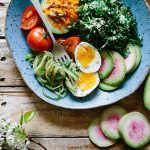Blue and purple might be rare colours in your daily diet; but by eating foods illuminated with these colours you can increase the level of antioxidants you consume and even improve your portion control.
Why Blue and Purple Foods?
The antioxidant power provided by blue and purple foods comes from the presence of two main chemical compounds: anthocyanins and betacyanines. There are six types of anthocyanins found in pink, red, mauve, violet and blue colours of flowers, fruit and some vegetables. The health benefits of anthocyanins come from their strong antioxidant power which allows their radical scavenging activity. Among the health benefits that result from their antioxidant activity are the prevention of inflammatory and cardiovascular diseases as well as a protective effect over several types of cancer.
The other blue chemicals, betacyanins, are most famously found in red beetroots. Betacyanins are the red pigments responsible for the rich colours of beetroot juice and were historically used to add an extra touch of colour to wine. Beetroot is a low calorie veggie which is loaded with vitamins, minerals and antioxidants. Just one cup will provide you with 27% of your required intake of folic acid, 50% your daily vitamin C, and 7% of potassium required for the day. The root is also rich in other nutrients like B-complex vitamins and carotenoids (most associated with the colour orange). Transform beetroot into soups, juices and grate it to top salads, wraps and more. Their tops are usable and nutritious too; use them for extra iron.
Berry Power
Berries, rich in bioactive compounds, are a type of fruit that has been surprisingly well-researched. The more intense the colour, the higher the content of our chemical compounds generally is. They are low in energy and are easy to eat which makes them a practical snack or part of an easy breakfast. A cup of berries can provide you with more than 50% of your recommended amounts of manganese and Vitamins C and B9 (folic acid). Blackcurrants, blackberries, raspberries, elderberries, and strawberries all contain different levels of anthocyanins. These all help control diabetes and in the prevention of colds, flus and even cognitive decline.
The Magic of Blue
In 1865 a Belgic scientist called Delboueuf discovered that our perception of size can be tricked. When a small circle, for instance a plate, is found within another greater circle, such as another plate or the table cloth, our perception of the size of the first one can vary according to the colour and size of both circles. So, if the plate you eat in is darker, the amount of food you eat will appear to your brain to be more. Studies have shown that people who ate from blue plates ate less than those who ate from white plates. This is known as the Delboeuf illusion. The explanation of this optical illusion is found in the contrast of the colours. If you eat pasta from a white plate it is more likely that you will end up eating more than you wanted, which occurs commonly in restaurants. However eating pasta from a darker plate will help you feel more satisfied sooner. So, if you are watching the amount of food you eat try eating in darker plates such as blue.
See Also: 5 Common Myths about How to Eat Healthy, and Why to Ignore Them
Pale Blue vs. Dark Purple
There are some roots and even pulses and cereals that are violet or blue and therefore contain a higher nutritional value than its white counterpart. Some examples include potatoes, corn, rice and beans.
1. Blue Potatoes
Blue potatoes were first introduced to Europe from South America. Due to its amorphous shape and exotic colour, these tubers were originally thought to be poisonous and a thing of witchcraft. Later on people accepted the round, brown potato we know today. Our market still favours the perfect light brown potato, preferring to exclude the darker versions.
This is what people seem to prefer and therefore this is what supermarkets choose to sale. However, we are losing a lot of nutrition by sticking to brown potatoes. It doesn’t take more to grow and produce blue or red potatoes; the problem is that they just don’t sell as easily. Why choose the darker counterpart? Blue and red potatoes are not only rich in anthocyanins but also in carotenoids and phenolic compounds which will increase your antioxidant intake. Choosing blue or darker potatoes is likely to boost your nutrition; the only thing you would have to watch for is how you cook them.
A recent study showed that how you cook your potatoes matters. Frying them will only increase the amount of saturated fat you ingest but if you steam them the health-promoting compounds frond in raw potatoes are more likely to persist.
2. Corn
Blue corn gets its characteristic colour due to the presence of anthocyanins just like berries and wine. A study from the Journal of the Science of Food and Agriculture compared the nutritional content and quality of blue corn against its white counterpart. It was found that blue corn contained 7% less starch, a lower glycemic index and 20% more protein than the paler version. It’s not a surprise that their antioxidant level, owing to the content of anthocyanins, is also higher.
3. Rice and Beans
Similarly, dark blue or purple rice and beans contain higher levels of antioxidants and protein. A higher consumption of antioxidants means that the ability to neutralize free radicals is increased and cell damage is prevented which could otherwise lead to inflammation, Alzheimer’s disease, cancer and other degenerative diseases.
See Also: Yoga and Breast Cancer: Good for Every Step of the Journey
Try Some Blue!
One of the first senses that come into play when eating is your vision. Your eyes stimulate your salivary glands, and your gastrointestinal tract is triggered. Colour can help you eat healthier, control the amount of food you eat and generally feel healthy — and blue is an equally important colour to have on your plate. For higher nutrient and antioxidant power, choose foods with a darker colour. Give variety to your meals and experiment for a healthier you.













